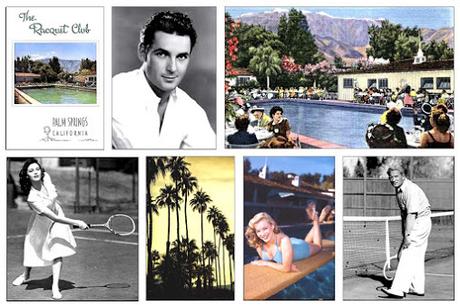
Charlie Farrell, top center; Ava Gardner, bottom left; on the right, Marilyn Monroe and Spencer Tracy
Many years ago, Charlie Farrell was a movie star. He first gained fame as a leading man in the late 1920s when he was in his late 20s. He'd started out in Hollywood as an extra, appearing momentarily in films like the Lon Chaney classic The Hunchback of Notre Dame (1923) and Ernst Lubitsch's first Hollywood film, Rosita (1923), starring Mary Pickford. After a minor role DeMille's The Ten Commandments (1923) his career began to build. In 1927 he was cast opposite Janet Gaynor in 7th Heaven. A smash hit, the movie was nominated for the very first Best Picture Academy Award and brought Oscars to director Frank Borzage, screenwriter Benjamin Glazer and to Janet Gaynor, who won Best Actress for this and two other film performances. Charlie would always joke that he was the only one connected with the movie who wasn't nominated for an Oscar. The two luminous, newly minted young stars were then teamed in 11 more pictures between 1928 and 1934 and, as the most popular couple in movies, were known as "America's Favorite Lovebirds."
Janet Gaynor and Charles Farrell in 7th Heaven (1927)
Though Charlie successfully transitioned to talkies, Fox Film Corp. was in flux. When William Fox lost control of the company after the stock market crash, Chase National Bank put his volatile protege, Winfield (Winnie) Sheehan, in charge. Sheehan was not a Farrell fan. Some said it was because the boss had an eye for Janet Gaynor and was miffed that she'd been romantically involved with her co-star. But, at the same time, the trend in leading men was shifting toward "tough guys," which Farrell was not. Looking back on his career much later, the dapper Massachusetts-born/Boston University-educated Farrell would admit he'd gotten weary of "trying to portray James Cagney" when his accent sounded "more like James Mason's."

The Desert Inn (left) and the El Mirador, two early destination resorts in Palm Springs
Charlie Farrell reportedly got his first glimpse of Palm Springs in 1929 when the studio sent he and Janet Gaynor to the desert for voice training. This was in preparation for converting their film Lucky Star (1929) from silent to sound. Palm Springs was then in the beginning stages of its transformation from modest health spa town with a few dude ranches to ritzy winter retreat for the wealthy and well-known. The Lloyd Wright designed Oasis Hotel opened in 1925 and on New Year's Eve 1928 the sprawling El Mirador Hotel threw open its opulent doors. The Desert Inn, where Charlie stayed during his visit, was a poshly renovated and repurposed former spa.
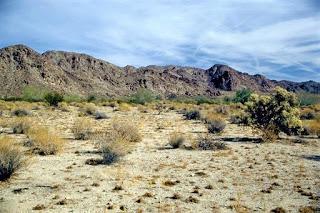
sagebrush and sand
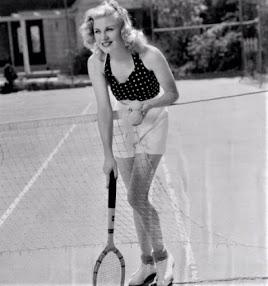
Ginger Rogers
The courts opened in December 1934. The facilities were spare and amenities non-existent, but top Hollywood stars attended Farrell and Bellamy's "grand opening" anyway, among them Carole Lombard, Joan Crawford, Spencer Tracy, Marlene Dietrich, Ginger Rogers, Robert Taylor, Frank Morgan, Mary Pickford and Douglas Fairbanks. The two men hadn't originally intended to turn their sandy lot into a club but, as Charlie put it 30 years later, "Places like the Racquet Club are not planned. They just happen."
The Racquet Club soon sported a clubhouse, a full restaurant and bamboo bar (designed by Hollywood director Mitchell Leisen), guest bungalows, a swimming pool with poolside dining, locker rooms, showers, and four more tennis courts. Far enough away from Hollywood for movie folk to let their hair down in relative privacy, but near enough to get back within the two hours required by the studios, the Racquet Club became a haven for film stars. By 1936 the club had sold all available memberships and closed its list to new applicants.
A recent video tour of the Charlie Farrell residence, where he lived for nearly 40 years
In 1934 Charlie and his wife, former actress Virginia Valli, built a house on the Racquet Club grounds that would be their desert home for the next 18 years. In 1952 they moved to East Tachevah Drive in the Movie Colony compound and remained their for the rest of their lives. Charlie bought out Ralph Bellamy's interest in the business in 1937 and from then on oversight fell entirely to the Farrells. Charlie played the role of host/ringmaster and Virginia kept an eye on the business side. To supervise day to day operations, they hired a general manager.Together Charlie and Virginia were, according to one longtime club member and Palm Springs resident, "the backbone of the club - and the town."
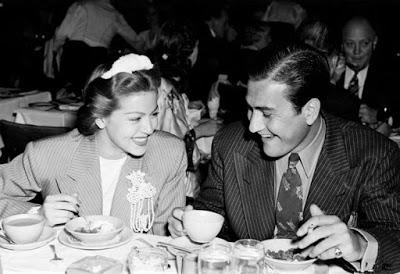
Lana Turner and Artie Shaw honeymooned at the Racquet Club
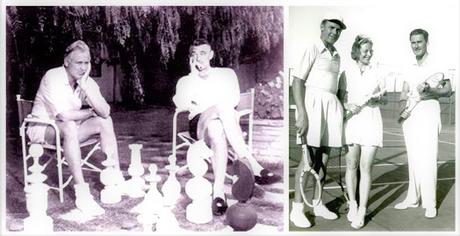
Racquet Club days: Charlie and Clark Gable play chess; Charlie with tennis champ Alice Marble and Errol Flynn
New Year's Eve at the Racquet Club was the place to be for members who were in town over the holidays, and reservations sold out months in advance. The main dining room would be packed to the rafters, with the likes of Alice Faye and Phil Harris providing impromptu entertainment. At one party Dixie Lee Crosby, Bing's first wife, quietly pressed Charlie to ask Bing to sing. She said her husband was feeling blue because no one, so far, had asked. Charlie said sure, but he didn't get to it right away. Walking through the bar a bit later, he realized that Bing had left the party because there he was, alone at the piano singing all by himself. Of course, Bing was quite familiar with the club's Bamboo Bar, even knew it well enough to occasionally take over for Tex George and mix drinks for the crowd. And Bing, no doubt, was adept at making one of the club's trademark cocktails, the Bloody Mary. Local lore has it that it was Charlie Farrell who dreamed up the drink as a morning-after "hair of the dog" antidote for pesky hangovers. Although New York's 21 Club has claimed to have originated the Bloody Mary, Palm Springs historians insist the recipe was appropriated from the Racquet Club.

Bill and "Mousie" Powell
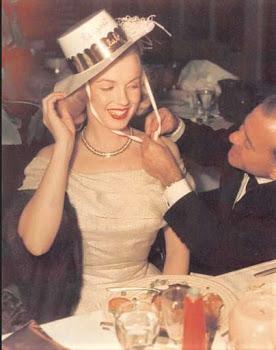
Marilyn Monroe and Johnny Hyde at the club on New Year's Eve
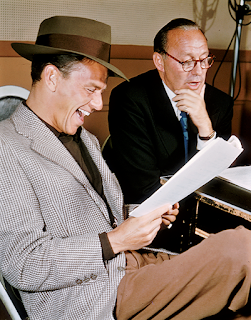
On the radio: Frank Sinatra and Jack Benny
In 1932, Jack Benny's radio show hit the airwaves. It was a great success and aired for another 33 years. From the early '40s through the early '50s, the program periodically broadcast from Palm Springs. These shows sometimes featured a segment known as "Murder at the Racquet Club" and Charlie Farrell guested on these episodes. Benny usually referred to him in jest as "the star of 7th Heaven," a 20 year old film by that time. Other Hollywood names who were in town - like Peter Lorre, Sam Goldwyn, Frank Sinatra and others - also took roles in these sketches. The club itself was subject to a lot of ribbing, with jokes about its standing as a Hollywood hangout ("all that ham around there isn't just for sandwiches") and especially for its reputation for exclusivity. An early episode has Benny, as the local police chief, demanding entry to the club so he can investigate a murder that's taken place there. "Are you a member?" he's asked. "No," he says. "If you're not a member, you can't come in. I'll have to throw the body over the fence," he's told. In a later episode Benny, again as police chief, asks why most of the murders in Palm Springs seem to happen at the Racquet Club. "Because people here don't want to be caught dead anywhere else," is Charlie's reply.

Gale Storm and Charlie Farrell in My Little Margie
By the time Charlie made his last film in 1941, he had acclimated to Palm Springs life. Not only was he immersed in the Racquet Club, but he was also acting as an editor and columnist for a local newspaper and was playing regularly in weekly polo matches. Then came World War II and naval service. When he left the Navy in 1945, having risen to the rank of Lieutenant Commander, Charlie got involved in local politics. He was elected to the Palm Springs city council in 1945 and became mayor in 1948. He served as mayor for five years and resigned during his run as co-star of the popular TV sitcom My Little Margie (1952 - 1955) and its the radio counterpart. After Margie ended he undertook his own TV series, The Charlie Farrell Show, for CBS. The comedy was set at the Racquet Club and fictionally mirrored his own life as owner/manager and retired movie star. It was a summer replacement for I Love Lucy in 1956 and would re-air during the summers of 1957 and 1960.

Charlie Farrell played a key role in the growth and prosperity of Palm Springs from early days. He brought the stars and, thus, the spotlight to town. He served in city government for eight years and, for decades, was the town's most high profile promoter and spokesperson. For all of this and because his name had become synonymous with the place, he was known with affection as "Mr. Palm Springs." Farrell Drive, a winding thoroughfare that intersects with the street where he lived, was named in his honor and his residence on East Techevah Drive would, in time, be officially designated a historic site.
In 1959, the Racquet Club was sold for $1.2 million. Financially, the Farrells were set. As for keeping himself busy, Charlie would be contracted through a second change of ownership to operate as managing director, host and public face of the Racquet Club. When he left at the end of the '60s after his wife Virginia passed away, the club's glamour years were effectively finished. Decline set in with a series of sales and management changes and as of 2011 it stood empty. Following a devastating fire in 2014, the Racquet Club was razed. One Palm Springs resident spoke of the significance of the Racquet Club's demise. "This is a loss to everyone in Palm Springs," he lamented, "because this was the birth of Palm Springs."
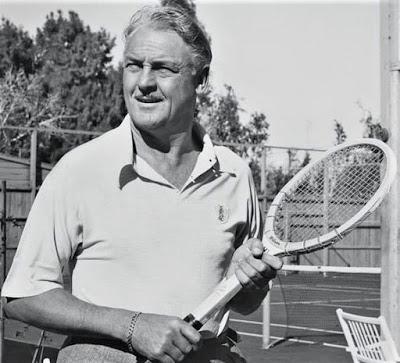
"Mr. Palm Springs"
Charlie Farrell lived out his life on East Techevah Drive, passing away at home in 1990 at age 89. Reflecting back on his years in movies, radio and TV, he once told an interviewer, "I had a helluva career." In fact, he had a helluva life.
~
Members and guests on the scene at the Racquet Club
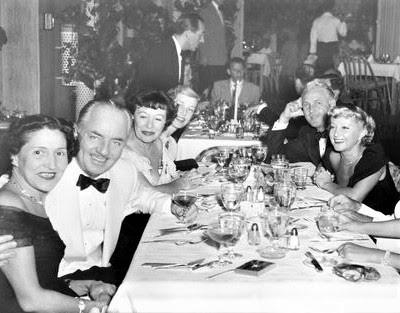
Left, Louella Parsons and Bill Powell; right rear, Charlie and Mousie; Back table, Frank Sinatra
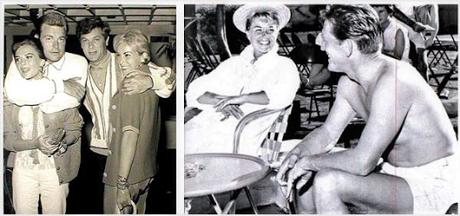
Left: Natalie Wood, Robert Wagner, Tony Curtis, Janet Leigh; right, Doris Day and Kirk Douglas

Audrey Hepburn and friend in the desert sun
The Charles Farrell Salad, recipe from A Treasury of Great Recipes: Specialties from the World's Foremost Restaurants by Vincent and Mary Price
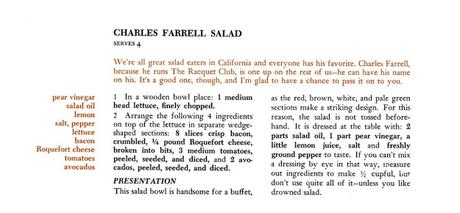
Sources
Sports Illustrated, “Charlie’s Seventh Heaven” by Alfred Wright, April 15, 1963
A Treasury of Great Recipes: Famous Specialties from the World's Foremost Restaurants by Vincent and Mary Price, Bernard Geis Associates, 1965
Palm Springs Public Library History Project, Mousie Powell interview, July 15, 1987 (YouTube)
Los Angeles Times, “Charles Farrell, 89; Film and TV Actor, Developer, Former Palm Springs Mayor,” by Burt A. Folkart, May 11, 1990
Palm Springs Life, “Creating a Racquet (Club)” by Gloria Green, December 8, 2012
The Desert Sun, “Racquet Club Attracted Hollywood to Palm Springs,” by Renee Brown, July 2, 2016
Palm Springs Life, “Love Match” by David Lansing, Sept. 1, 2016

